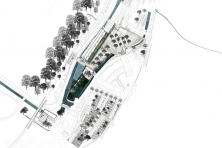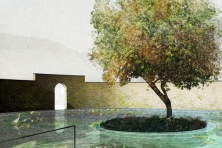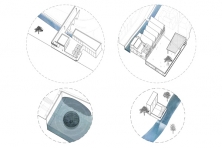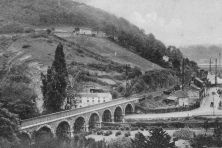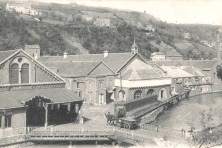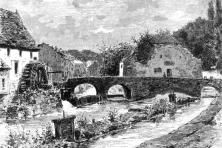Initiate resilience
Huy (BE) - Special Mention
TEAM DATA
Team Representative: Benjamin Froger (FR) – architect
Associates: Fanny Costecalde (FR), Guillaume Wittmann (FR) – architects
éjo. coopérative d’architecture
71 boulevard Barbès 75018 Paris (FR)
+33 680827393 – ejo.cooperative@gmail.com – éjo-cooperative.com
See the complete listing of portraits here
See the site page here

G. Wittmann, F. Costecalde & B. Froger
INTERVIEW
Click on the images to enlarge
1. How did you form the team for the competition?
Our collaboration has been effective for years now. It has been established naturally and has become obvious today. The projects or competitions we did together during many years, especially Europan 12, have consolidated our team constitution, born from sharing references, and a common vision of our discipline.
2. How do you define the main issue of your project, and how did you answer on this session main topic: the place of productive activities within the city?
Huy, the city studied, has welcomed varied and flourishing activities, for decades, punctuating the Hoyoux valley of major installations in terms of area, employment, reputation… If most of the buildings witnessing this prosperous era, it has been torn down, the void generated by its decline reveals its history. Our project relies above all on this heritage, and includes its impact on the environment, whether positive or not, relaunching production within the city, and on a larger scope, along its valley. On the project site, whose soil is polluted, we wished to preserve the major buildings and inject mixed uses: laboratories and housing linked to the hospital, leaving a polyvalent public space able to welcome cultural and social activities, but also expressing the productive aspect of the new surrounding buildings.
3. How did this issue and the questions raised by the site mutation meet?
The project title refers to the ecologic definition of the term “resilience“, or how an ecosystem reaches an usual functioning, autonomously and with its own resources. Our work started by a precise inventory of the past or present activities established along the Hoyoux valley: steel industry, paper mill, sawmill, viniculture, nuclear… Some of these activities still remain, others only kept their expertise from the past, and some of them, disappeared, today some tracks of these activities stick to the territory by their long term pollution impact on the environment. The project, we propose, establishes its major activity thanks to the interaction between the hidden potentials of the site, and the actions required to repair the past damages. Initiate resilience…
4. Have you treated this issue previously? What were the reference projects that inspired yours?
Our participation in the previous editions was an opportunity to initiate a study about the way to define project intentions thanks to the inventory and the use of local resources. This edition enabled us to develop this work research. This method prioritizes the identification of punctual interventions points, measured and adjustable to a global and uniform planning. These “punctuations” constitute, by their interaction and their synergy, the support of productive and dependent activities. Our references highlight this constant search of a measured operation, considering that the scope of the project is not related to its built dimension.
5. Urban-architectural projects like the ones in Europan can only be implemented together with the actors through a negotiated process and in time. How did you consider this issue in your project?
We believe that our involvement to an urban and architectural project can only be the beginning of a long-term process, which is never set. Besides, our projects are often constituted by a grid of small scale interventions. Then the notion of “measure”, previously mentioned, joins the temporal and financial reality of a concrete project. We try to initiate, by a progressive approach an ongoing development, in potentially endless way. On this project we thought to the notion of productive and adaptable city by proposing several « first steps », impulsions for incoming developments and a phasing for each site. This first “long time” allows us to consider the decontamination issues of the sites before any built operation, and take into account the expectations of a potential contracting authority.
6. Is it the first time you have been awarded a prize at Europan? How could this help you in your professional career?
Our team has been awarded “runner-up” during the Europan 12 edition, for a project in Porto Brandão (PT), located on the South side of the Tage, in front of Lisbon. The municipality initiated after this a workshop with the awarded teams, extended by a contract for an urban study answering to the initial issues. On the aim to highlight our work and efforts, we expect that this new prize could lead to a complete mission, despite the challenge to name architect a team awarded from ideas competition.
